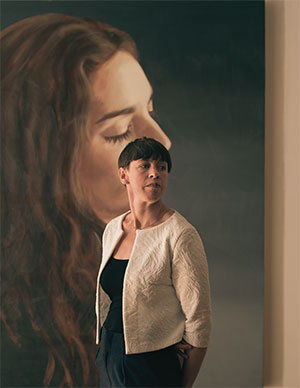“We typically tolerate disability. That’s the capacity of legislation, to tolerate disabled people,” says Eliza Chandler, speaking to the limits of the Accessibility for Ontarians with Disabilities Act. While the aim of the AODA is to help make public buildings and businesses more accessible, Dr. Chandler’s teaching practice and research as an assistant professor at Ryerson University’s school of disability studies is more interested in the ways cultural production furthers disability rights. “We need access to art galleries, and art studios, access to being understood as desirable, sexual – all of these things that can’t be protected by a human rights framework,” she says.

University’s school of disability studies, is co-leading a $2.5-
million project to study how art and culture
can lead to practical change for
people with disabilities. Photo by Ian Patterson.
As an artist, Dr. Chandler says she didn’t always make the connection between her own disability and her practice. She says not articulating that connection during her studies in film and sculpture at the Nova Scotia College of Art and Design put limitations on the kinds of work she could produce. It wasn’t until she moved to Toronto in 2001, and found the Abilities Arts Festival (now called Tangled Art + Disability) that the connection became clearer.
Tangled is a disability-led initiative to mobilize the disability arts community in Toronto. Dr. Chandler says it opened her up to the creative and cultural benefits of a disability aesthetic, both in her work and in the work of others. She describes the aesthetic as “[inviting] us to be satiated by the differences disability brings. If you as the audience are compelled, intrigued, interested, curious or made uncomfortable by it [disability art], then that changes understanding and can lead us from tolerating disabled people to desiring.”
Dr. Chandler continued her studies, getting a PhD in social justice education at the University of Toronto. In 2014, she was named the Ethel Louise Armstrong Post-Doctoral Fellow at Ryerson’s school of disability studies, a position created specifically for a disabled woman. That same year she became artistic director at Tangled (a post she held until she joined Ryerson’s faculty full-time this past fall).
As a grad student, Dr. Chandler’s growing interest in the local disability arts community led to working with Carla Rice, who holds the Canada Research Chair in Care, Gender and Relationships at the University of Guelph. The initiative, called Mobilizing New Meanings of Difference in Disability, gave artists with disabilities the chance to work together in an art project that challenged the dominant medical conceptualizations of disability. She has paired up with Dr. Rice again to co-direct Bodies in Translation: Activist Art, Technology and Access to Life, a project focusing on the potential for art to disrupt conventional understandings of non-normative embodiments, including disability, deafness, madness, aging, and fatness. The project was recently awarded a $2.5-million partnership grant from the Social Sciences and Humanities Research Council.
Dr. Rice explains that Bodies in Translation builds on Mobilizing New Meanings of Difference in Disability. “It was through our work on that grant that Eliza and I realized we needed to scale up this initiative and be thinking more broadly about disability arts and studying [its] actual cultivation,” she says.
Dr. Chandler says such research is imperative as the disability community, the body of disability art, and interest in those works are all growing rapidly. “Arts councils, galleries, theatre companies and audiences are all becoming interested in disability arts. Now more than ever it’s important to reflect on where we’re going, and how to maintain our politics.”
This article is so important. I know that disability and art are related. I am a painter and graduated from Alberta College of Art and Design in May 2016. I am currently painting acrylic portraits in my art practice.
I am working on displaying my work in galleries. I have a developmental intellectual disability. I learn slower than the average person. I struggle with anxiety,and depression and making art makes me feel happier and less focused on my disability. I would love to be a part of this project, sounds great!
I’m amazed by this new perspective to reach equality